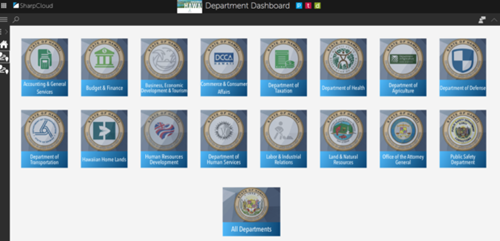Original Story from Honolulu Civil Beat
The Hawaii Department Dashboard’s robust yet simplified approach to visualizing complex data is spot-on as a tool in making more efficient, cost-effective, and transparent choices for the state’s IT expenditures and governance.
Last month, Hawaii Chief Information Officer Todd Nacapuy presented the online dashboard to nonprofit, government, and tech industry professionals at Impact Hub Honolulu.
In a few clicks, the award-winning dashboard shows project timelines, financial overviews and project statuses of nearly half a billion dollars of IT projects across 16 departments in the executive branch. It even outlines delayed projects and is upfront about reasons for setbacks.
So far data from the tool enabled the state of Hawaii to significantly lower the bill for common software critical to the government’s function. Such was the case when Nacapuy’s office, the Office of Enterprise Technology Services, reduced the state executive branch’s Adobe Acrobat Pro software expenditures from $2 million to $475,000.

A screen shot from Hawaii Department Dashboard’s website.
Moreover, through its empirical nature, the data conveys a collective story for multi-year projects and helps in stating justifications for upcoming modernization requests. The factual approach is both helpful and unmuddied by hearsay or the influence of interest groups.
The Hawaii Department Dashboard is an excellent first step in the area of government transparency and data accessibility. In fact, the Office of Enterprise Technology Services was recently recognized with an industry award for its digital innovation by way of data visualization.
Maximum Coordination
It takes a team to keep the Hawaii Department Dashboard consistently accurate and functional. The state office meets monthly with the departments to validate information on current and future projects. In addition, two state employees maintain the fiscal IT dashboard with continuous input from department’s IT leads.
Creation of the dashboard was made possible by Senate Bill 2807 SD2 (signed into law as Act 58 of 2016) which strengthened the CIO’s authority to work with each executive branch department and agency to develop and maintain its respective multi-year IT strategic and tactical plans and roadmaps.
Who is taking advantage of this resource? Now that the state departments and the Legislature have enhanced access to the state’s major IT projects statuses and budgets, they should take advantage of this opportunity to maximize coordination across branches and use it to hold each other accountable.
While the Hawaii Department Dashboard is a major achievement, the State of Hawaii can’t rest on its laurels. A handful of other online dashboards were created years ago to measure state priority objectives and make public data accessible, but many of them are out of date resulting in inadvertently leaving the public in the dark about progress altogether — or left to navigate the rabbit hole of state websites which takes significant amounts of time. Some of these dashboards were last updated in 2016.
Given the decentralized nature of Hawaii’s state government, we must continue to move forward faster and with an even greater urgency to advocate for statewide coordination in the government’s digital transformation.
There is another opportunity before us to propel Hawaii state government toward winning back the public’s trust. In May 2018, the Legislature passed HCR 94, a resolution which requests the development of a state information technology strategic plan, to include data goals and objectives. The strategic plan presents a much-needed opportunity for the state to gain momentum in moving transparency measures and initiatives forward, not just in IT, but for all departments that use IT to conduct state business.
The responsibility of developing the plan, with the input of state agencies such as the Office of Enterprise Technology Services and the Office of Information Practices, is in the hands of the IT Steering Committee, on which I am proud to serve.
As a committee member, and in my role as executive director of Transform Hawaii Government, I strongly believe that the availability of the public’s data applied to analysis technology will only benefit Hawaii at large by enabling stakeholders such as state departments and legislators to understand trends, monitor changes, address the Hawaii’s pressing issues, and furthermore forecast desired outcomes for the many programs and services offered by the state.
“We’ve never been able look at departments to analyze their data,” CIO Nacapuy said of the departments’ IT roadmaps at the conclusion of his presentation. “It’s about data; that’s the true power of why we’re doing this modernization.”

